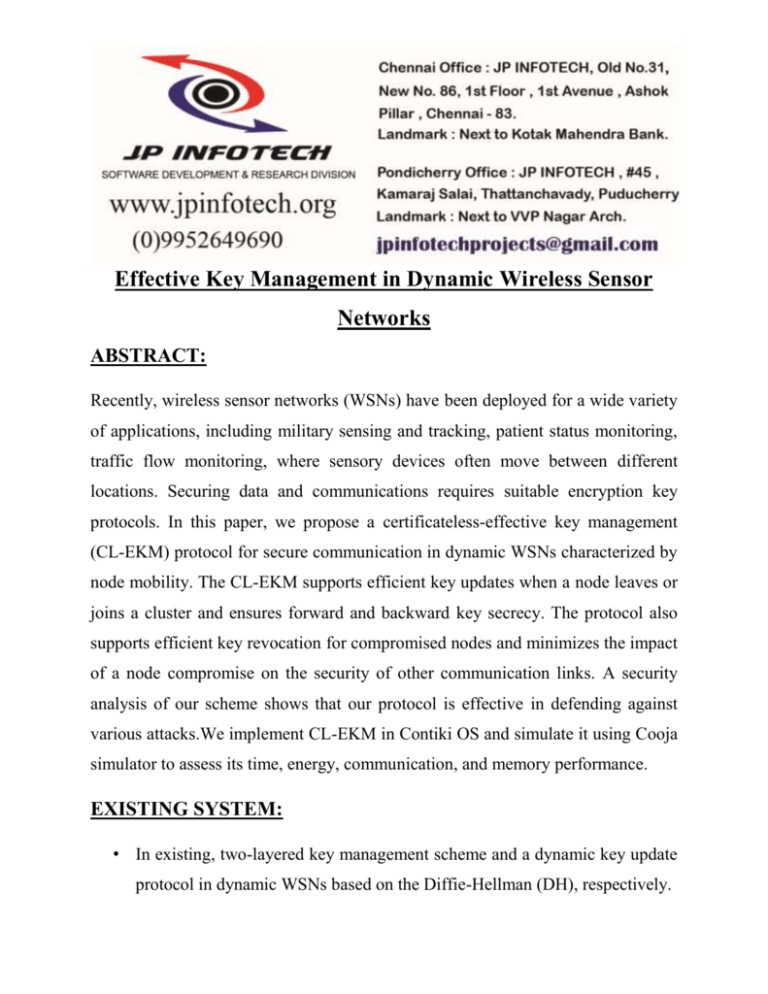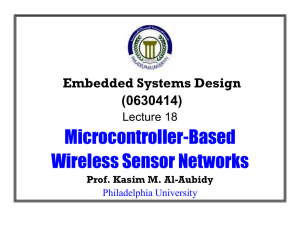Effective Key Management in Dynamic Wireless Sensor Networks
advertisement

Effective Key Management in Dynamic Wireless Sensor Networks ABSTRACT: Recently, wireless sensor networks (WSNs) have been deployed for a wide variety of applications, including military sensing and tracking, patient status monitoring, traffic flow monitoring, where sensory devices often move between different locations. Securing data and communications requires suitable encryption key protocols. In this paper, we propose a certificateless-effective key management (CL-EKM) protocol for secure communication in dynamic WSNs characterized by node mobility. The CL-EKM supports efficient key updates when a node leaves or joins a cluster and ensures forward and backward key secrecy. The protocol also supports efficient key revocation for compromised nodes and minimizes the impact of a node compromise on the security of other communication links. A security analysis of our scheme shows that our protocol is effective in defending against various attacks.We implement CL-EKM in Contiki OS and simulate it using Cooja simulator to assess its time, energy, communication, and memory performance. EXISTING SYSTEM: • In existing, two-layered key management scheme and a dynamic key update protocol in dynamic WSNs based on the Diffie-Hellman (DH), respectively. • However, both schemes are not suited for sensors with limited resources and are unable to perform expensive computations with large key sizes (e.g. at least 1024 bit). • Since ECC is computationally more efficient and has a short key length (e.g. 160 bit), several approaches with certificate have been proposed based on ECC. • However, since each node must exchange the certificate to establish the pairwise key and verify each other’s certificate before use, the communication and computation overhead increase dramatically. • Also, the BS suffers from the overhead of certificate management. Moreover, existing schemes are not secure DISADVANTAGES OF EXISTING SYSTEM: • Unable to access with large size of keys • Increase the overhead • Cannot provide more secure • Resolve the key escrow problem PROPOSED SYSTEM: • In this paper, we present a certificateless effective key management (CLEKM) scheme for dynamic WSNs. • In certificateless public key cryptography (CL-PKC), the user’s full private key is a combination of a partial private key generated by a key generation center (KGC) and the user’s own secret value. • The special organization of the full private/public key pair removes the need for certificates and also resolves the key escrow problem by removing the responsibility for the user’s full private key. • We also take the benefit of ECC keys defined on an additive group with a 160-bit length as secure as the RSA keys with 1024-bit length. ADVANTAGES OF PROPOSED SYSTEM: • Provide more security • Decrease the overhead • Protects the data confidentiality and integrity SYSTEM ARCHITECTURE: BLOCK DIAGRAM: N2 N5 N1 STORAGE NODE N4 N3 N6 SYSTEM FLOW: SYSTEM REQUIREMENTS: HARDWARE REQUIREMENTS: System : Pentium IV 2.4 GHz. Hard Disk : 40 GB. Floppy Drive : 1.44 Mb. Monitor : 15 VGA Colour. Mouse : Logitech. Ram : 512 Mb. SOFTWARE REQUIREMENTS: Operating system : Windows XP/7/LINUX. Implementation : NS2 NS2 Version : NS2.2.28 Front End : OTCL (Object Oriented Tool Command Language) Tool : Cygwin (To simulate in Windows OS) REFERENCE: Seung-Hyun Seo, Member, IEEE, Jongho Won, Student Member, IEEE, Salmin Sultana, Member, IEEE, and Elisa Bertino, Fellow, IEEE, “Effective Key Management in Dynamic Wireless Sensor Networks”, IEEE TRANSACTIONS ON INFORMATION FORENSICS AND SECURITY, VOL. 10, NO. 2, FEBRUARY 2015.











